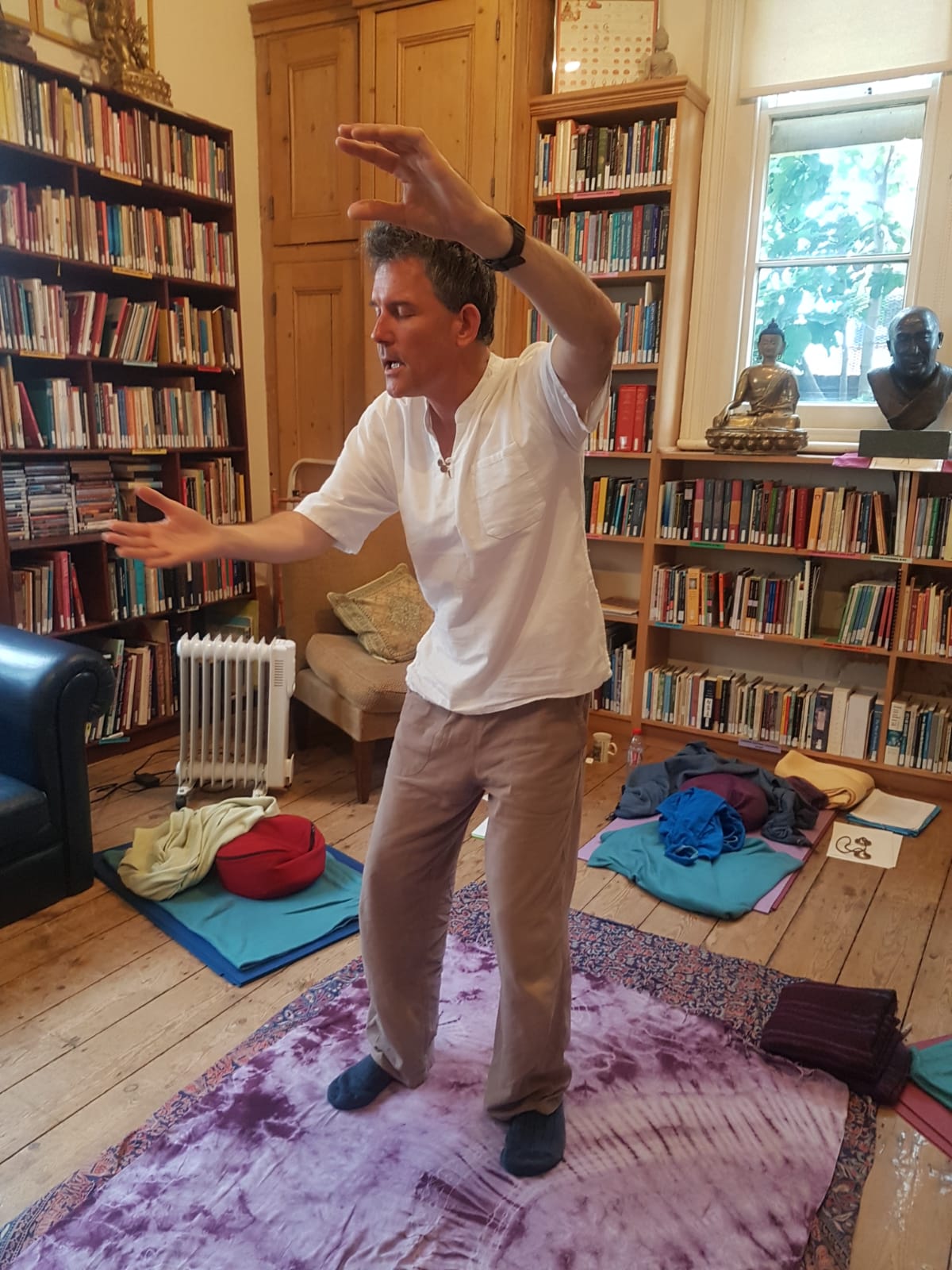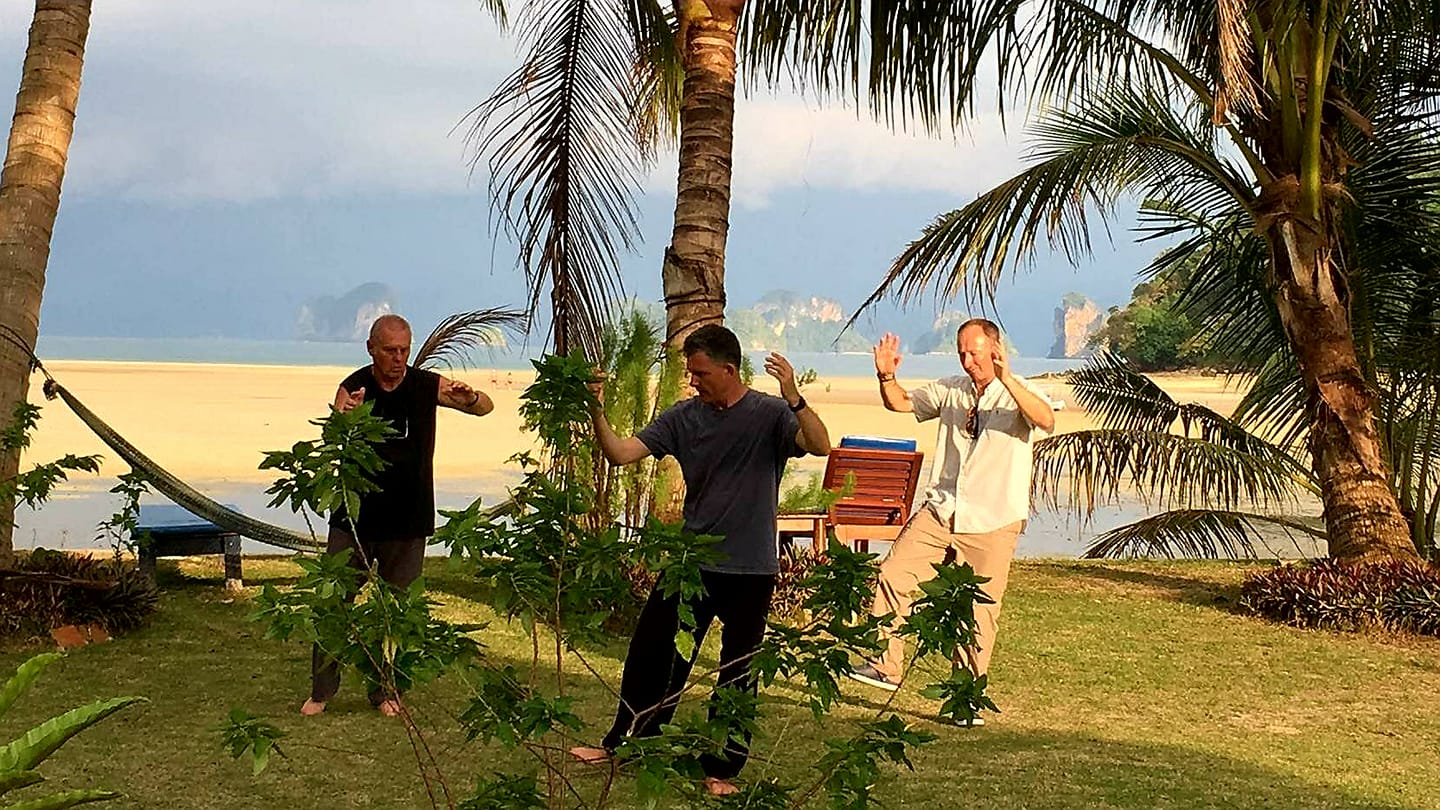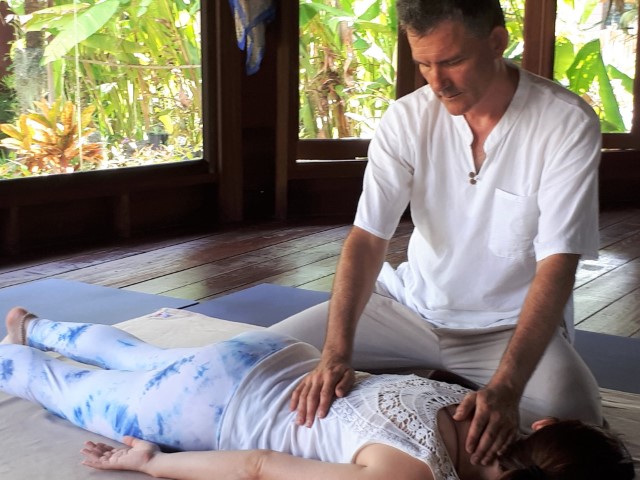
EasternPeace Hara Conditioning
Hara Conditioning is the 'Embodied Mindfulness' aspect of my Zen Mindfulness training and can be learnt as a standalone practice.
It is a blend of Japanese Katsugen Undo Regenerative Movement and Tai Chi Body Conditioning exercises.
- A rejuvenation practice which helps us regain our inner vitality and aliveness.
- A training to recover our body's natural wisdom and protective powers.
- A mysterious healing practice, in which health issues may cease to be 'required' and disappear.
- A great way to deal with body pain.
- An amazing embodied mindfulness practice which cuts through states of emotional / mental imbalance and trauma.
What more can I say!
What is Hara Conditioning?
 God knows what I'm doing!
God knows what I'm doing!Something my body wanted for some reason...
Just Sitting otherwise known as Zazen is an amazing practice.
But there are times when other ways may be more beneficial, especially if you have emotional / mental health difficulties or trauma. I believe what I call Hara Conditioning meets this need.
Hara Conditioning blends Japanese Katsugen Undo regenerative movement with Tai Chi Body Conditioning exercises.
There are also influences from Chi Nei Tsang / Thai Abdominal Massage and Dao Yin self-massage.
This fusion came about naturally as I worked to find better ways to help my students and then started to explore intensively within my own daily practice.
My body does the creative work. I just give it lots of time!
I've been blessed over the years with access to the root masters in China & Japan.
The aim of Hara Conditioning
The aim of Hara Conditioning is as it sounds, to strengthen the Hara, the spiral of energy or life force that underpins the human being, with special focus on cultivating the abdominal centre, the rest of the body being trained to move as one around it.
The Tai Chi aspect is an amazing system in itself, and superb for ones health, but I've deepened the sensitivity of it by bringing in more spontaneous adaption of the martial body training movements to meet therapeutic needs.
The patterns of the basic exercise at the same time as being enhanced by the Katsugen, help us to relax and 'have something to do', while the body warms up and feels safe to let go into the spontaneous unknowns that come up in Katsugen. For some, this is not easy to do.
The Katsugen is the real magic in this work and is often called regenerative movement as the life force is renewing or re-ordering itself.
This re-ordering is crucial. I would say most illness patterns whether mental or physical are associated with a distortion of the Ki of the person, creating a certain 'ordering' pattern to the body. Katsugen cuts through this static pattern, opening up the possibility of a fresh, healthier order coming into being.
And consequently we change or grow.
The Roots of Katsugen Undo
I see Katsugen Undo as a natural dynamic Zen practice, though traditionally in Japan there is more of a connection with Shinto.
I learnt it with a Japanese Ki & Shiatsu Master, Akinobu Kishi who shared it as part of his Sei Ki training.
I also explored it with Kayo Tatebe, one of the old masters of Noguchi Seitai. Haruchika Noguchi 1911-1976 was the charismatic founder who popularised this work in Japan.
There are similar practices within the Chinese traditions and in many of the cultures with strong shamanic traditions.
The way of entering the state varies, but the experience is rooted in the body, not the culture and this is universal.
What do I mean by Katsugen?
The body has an inbuilt intelligence to manage its inner balance, a homeostatic force which keeps us alive every minute, by adjusting the balance of chemicals and temperature.
This intelligence goes much further, but for most people it has been repressed by the control habits of the conscious mind.
Through the training we learn to relax the mind and allow the natural intelligence in the body to move us or cause us to express sound or emotion.
Letting go of 'control' can be challenging for many people, as you don't know what 'you' will do, but it is superbly healthy for us to do, especially when there are 'mental health' type difficulties or extreme emotional holding patterns.
The practice is about establishing a more natural relationship between the conscious mind and deeper aspects of the body intelligence.
For me it is a mutual meeting in which both parties are there to learn and humble themselves a little and come to respect of the other.
The conscious mind needs to learn to relax and trust the 'unconscious', but equally the 'unconscious' needs to learn to respect the intentions and needs of the conscious mind as well as the energy levels of the body. It may need to learn patience.
I'm not sure whether people will be able to understand these words without experiencing the work with me in a class. But they give you a feel of what to expect.
The energy coming through can be anything from 'deep relaxation into a hot bath', to 'releasing tears', to contagious laughter and craziness to something feeling like the Warrior Haka.
What you end up with is an amazing embodied mindfulness practice which cuts through states of 'mental health' and trauma.
The body intelligence with a wisdom far greater than our conscious minds could dream of cleans itself of the mental/emotional/physical complexes and traumas limiting it as it follows its desire to shift toward greater aliveness and vitality.
We can see this in action in the trauma release mechanisms that wild animals display, shaking spontaneously to throw off the chemicals left in their body from being in a dorsal vague freeze state after being captured.
But it is equally present in the shaking of horses, stretching and yawning of cats and the tossing and turning of young children in bed.
And we as adults can remember this capacity also.
The Importance of energizing breath for dealing with older trauma.
An important element of the practice is 'priming' with the breath.
I have noticed on occasions when my bodymind has been suddenly overcome by a terrible emotional state, that my body will spontaneously go into Katsugen to free itself, once my mind has loosened and given it space. There was no need for the priming breath.
This is a healthy natural response that is strengthened when your body has 'remembered' its katsugen capability, but it will usually be a short release.
At other times while do intentional sessions, when there was no acute tension or stress situation and a more established imbalance was being challenged, then the pre-energising practices felt important.
They help my body to soften, giving it vitality to process the changes and deal with what may be a much longer session than the 'natural' ones.
At times when I haven't done this I've been left depleted and sometimes ungrounded.
So for me, even though it is possible to enter katsugen without a 'warm up', I generally like to follow a pre-energizing process before allowing the system to take over. Lots of good yawning...
We still usually want to lie down and melt into the ground afterwards or chill out on the sofa, perhaps with legs in the air!
It feels good...
Final Words...
I am confident, if more people had access to these practices, alongside resonance connection ones like Sei Ki or my simpler HeartTouch, then the psychiatric hospitals would be less busy!
This is a practice which has to be experienced. My words only prejudice the work, but are hopefully useful pointers.
What you want is that sense of 'ping' inside - I want to try this... :)
Hara Conditioning Exercises
Usually I teach the practices as a spontaneous medley & never know how it will turn out:
- Walking into Mindfulness
- Blowing, Yawning & Open Throat Breathing
- Tai Chi Abdominal Practices
- Self Chi Nei Tsang Abdominal Massage
- Tai Chi Joint Release Exercises
- Spontaneous Stretch Taisos
- Katsugen Undo
- Dao Yin
- Lying Down / Qi Yoga to integrate
To get you started, there are some basic teaching videos available on my Hara Conditioning Video Training page.
Important Notes
I usually recommend people with any mental health background to do it with other people if possible, at least until you are confident of what you can expect from your body / unconscious.
And for the first time please do it with an experienced teacher.
The practice is not dangerous, but it needs to be respected and understood as something sacred which touches deep aspects of our being.
The benefit of doing it with other people with experience is that their bodies will help co-regulate yours as you go into the katsugen.
For many years, my own 'energy' was ridiculously strong and I felt more comfortable releasing amongst 'tolerant' others as a group. I lost my voice for days afterwards on multiple occasions.
As Kishi would say, 'Shit coming out...'. Better out than in!
I chose to mix occasional sessions of katsugen with daily soft Tai Chi and this has worked well for me in dealing with what we can call a background of extreme states / psychosis etc. though I don't see it in a negative way.
There are other teachers in the UK and around Europe and it is good to work with different people. I am perhaps the most accustomed to working with people with mental health backgrounds.
Courses & Workshops
Hara Conditioning Classes
I am currently offering weekly Hara Conditioning / Katsugen sessions as a 'by invitation' tutorial class for up to 5 people on Zoom on Tuesday evenings.
 Anthony teaching Hara Conditioning on Zoom
Anthony teaching Hara Conditioning on Zoom
At first, I thought this kind of work didn't fit an online format, but very quickly I realised it was really nice to do.
The important thing is the resonance between us which has been really strong.
As part of building this resonance, I require people to book a 1-1 with me first before attending the classes, so we have time to get to know each other and I can teach the basics.
As with any of my classes, I am open to people with any mental and physical health condition.
I don't mind whether students have had a half body stroke or are diagnosed with acute psychosis.
What is important to me is that students want to learn the practices to improve the quality of their life and are willing to put in the effort to practice in their own time.
It doesn't need to be hours and hours every day, but at least a few minutes most days is important.
With this mindset, life can improve! And I enjoy walking that journey with you.
Contact Me if you would like to book a 'new attendee' 1-1 session.
News / Events
Upcoming / Ongoing Classes:
Tuesdays / Sundays 19.15-20.15 / 13.30-14.30
HeartTouch Classes for Well-being & Vitality
Date: 2/12/2025 - 10/2/2026
Where: Online -
More...
Upcoming Workshops:
tba 2026 : Sei Ki HeartTouch Emotional Bodywork Therapist Training
Where: UK -
More...
27/8 - 30/8 2026 : HeartTouch @ The Summer of Love Yoga Festival
Where: Kiental, Switzerland -
More...
16/10 - 18/10 2026 : Sei Ki HeartTouch: Working with Anxiety, Emotional Pain & Trauma
Where: Kiental, Switzerland -
More...
Holidays / Retreats:
Tai Chi for Well-being & Vitality
Date: 12/1 - 22/1 2026
Where: Koh Yao Noi, Thailand -
More...
Recently Completed Events:
23/11 2025 : HeartTouch: Working with Anxiety, Emotional Pain & Trauma
Where: London -
How it went...
15/11 - 16/11 2025 : Sei Ki HeartTouch Emotional Bodywork Therapist Training
Where: Bern, Switzerland -
How it went...
6/10/2025 - 10/11/2025 : HeartTouch Classes for Well-being & Vitality
Where: Online -
How it went...
Coaching:
Sei Ki Private Sessions
Sessions can take several forms:
- Sei Ki Touch Therapy Session for Health & Well-being.
- One-One HeartTouch Tutorial Session.
- Couples HeartTouch Tutorial Session.
- Small Group HeartTouch Tutorial Session - contact me for pricing.
- Katsugen Undo One-One Session.
I am happy to consider sessions with anyone whatever their state of physical or mental health.
I am open to invitations to run half-day or full-day tutorial training and may be able to travel to you.
Session Fee: £80 / hour
Upcoming Workshops & Retreats in Detail:
New: Thailand: Tai Chi for Well-being & Vitality

When: Jan 12th - Jan 22nd 2026
Where: Koh Yao Noi, Thailand
What: A 10 day, 20hr sunrise & sunset introduction to Small Circle Yang Style Tai Chi in an amazing setting. Maximum 4 students.
Why: To clear any stress, come to a good feeling within yourself & take home some new skills to maintain a deeper inner balance, peace and resilience.
Who: Anyone with a desire to learn Small Circle Tai Chi is welcome. Therapists keen to enhance their Qi sensitivity and capacity are very welcome. All my events are suitable for people facing emotional breakdown / burnout or trauma situations. This Tai Chi is a deep rejuvenation practice and will help.
Fee: 20 hrs - £600
New: UK: Sei Ki HeartTouch Emotional Bodywork Therapist Training

When: Date to be announced in 2026
Where: Venue to be announced
What: A One year Sei Ki HeartTouch Emotional Bodywork Training open to experienced bodyworkers with prior experience of Sei Ki HeartTouch, possibly Sei-Ki with other students of Kishi.
Why: To enhance your capacity to hold safe space for people with emotional and mental health issues and lay the foundations for a new emotional bodywork profession focused around embodiment and nervous system regulation.
Who: For licensed Shiatsu / Bodywork therapists.
Fee: Part 1: tba, Part 2: tba
New: HeartTouch @ The Summer of Love Festival

When: Aug 27th - Aug 30th 2026
Where: Kientaler Hof, Switzerland
What: Introductory Classes to HeartTouch and Treatments @ The Summer of Love Yoga Festival
Why: To come to a good feeling within yourself & enhance your capacity to hold safe space for others.
Who: Anyone interested to experience themselves in a more embodied, authentic, compassionate way and learn to connect with others from this place.
Fee: Free with Yoga Festival Ticket
To see all upcoming workshops:
Visit the Workshops Page...
